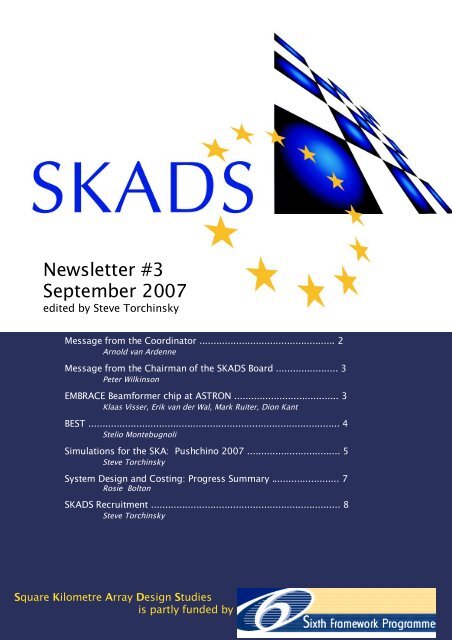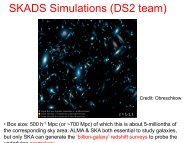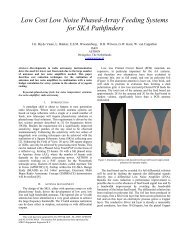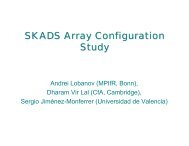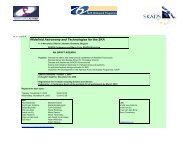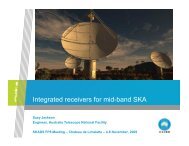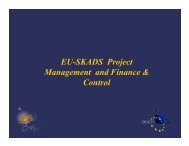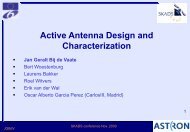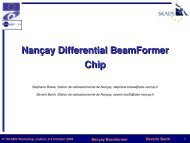SKADS Newsletter #3
SKADS Newsletter #3
SKADS Newsletter #3
Create successful ePaper yourself
Turn your PDF publications into a flip-book with our unique Google optimized e-Paper software.
<strong>Newsletter</strong> <strong>#3</strong><br />
September 2007<br />
edited by Steve Torchinsky<br />
Message from the Coordinator ................................................ 2<br />
Arnold van Ardenne<br />
Message from the Chairman of the <strong>SKADS</strong> Board ...................... 3<br />
Peter Wilkinson<br />
EMBRACE Beamformer chip at ASTRON ..................................... 3<br />
Klaas Visser, Erik van der Wal, Mark Ruiter, Dion Kant<br />
BEST ......................................................................................... 4<br />
Stelio Montebugnoli<br />
Simulations for the SKA: Pushchino 2007 ................................. 5<br />
Steve Torchinsky<br />
System Design and Costing: Progress Summary ........................ 7<br />
Rosie Bolton<br />
<strong>SKADS</strong> Recruitment ................................................................... 8<br />
Steve Torchinsky<br />
Square Kilometre Array Design Studies<br />
is partly funded by
Message from the Coordinator<br />
Arnold van Ardenne, <strong>SKADS</strong> Coordinator<br />
This third <strong>SKADS</strong> <strong>Newsletter</strong> is to some extent<br />
focused on the <strong>SKADS</strong> achievements leading up<br />
to the Mid Term Review in October and the<br />
second workshop preceding it. In preparation<br />
for these events, a new and updated <strong>SKADS</strong><br />
brochure is in the making and will be ready in<br />
September.<br />
Before that however, a lot has happened and has<br />
been summarised in the second Annual Report.<br />
The report illustrates and underpins the<br />
technological progress, the establishment of a<br />
framework of scientific and technical simulations<br />
and the development of a system level costing<br />
tool. While impressive in itself, it is also fair to<br />
say that <strong>SKADS</strong> has greatly enhanced the<br />
visibility of the SKA in Europe and elsewhere. As<br />
a result, <strong>SKADS</strong> contributed to the identification<br />
of the SKA on the ESFRI roadmap and provided<br />
input to the next step i.e. the European FP7<br />
programme PrepSKA aiming for the construction<br />
of the SKA. <strong>SKADS</strong> also firmly established its<br />
key technology area i.e. aperture arrays as a<br />
concept technology for the SKA. This<br />
technological scope is relevant to other<br />
implementations as well, for example, focal<br />
plane arrays.<br />
Thanks to all involved in <strong>SKADS</strong>, the scientific<br />
and engineering section of the Annual Report<br />
was ready on time and is available on the <strong>SKADS</strong><br />
wiki site. The final version will be posted on the<br />
<strong>SKADS</strong> website.<br />
Proceeding from the last <strong>SKADS</strong> <strong>Newsletter</strong>, the<br />
emphasis of <strong>SKADS</strong> activities supplementing the<br />
work in the DS’s was on (i) defining and<br />
specifying the architectural framework of the<br />
SKA against which the science and astronomical<br />
data simulations and costing, could be<br />
referenced; the “<strong>SKADS</strong> Benchmark scenario”. In<br />
this SKA scenario, the Aperture Arrays concept is<br />
assumed for frequencies up to about 1 GHz<br />
combined with a different high frequency<br />
concept (i.e. a small dish concept).<br />
(ii) Positioning and shaping <strong>SKADS</strong> as a coherent<br />
European pathfinder project inside Europe and<br />
elsewhere and to illustrate the technical and<br />
scientific feasibility of the Benchmark scenario<br />
(iii) defining a solid costing approach and<br />
system level costing tool which resulted in a<br />
report that was presented at the SKA ISSC<br />
meeting last March (iv) preparing and<br />
negotiating with IST-CENTRA from Portugal as<br />
new participant and preparing for the leave of<br />
four (University) participants (v) increased<br />
interaction with the International SKA (Project<br />
Office) activities at large (vi) executing of the<br />
FP6 Marie-Curie <strong>SKADS</strong> program in support of<br />
SKA(DS) science and technology toward<br />
educating younger people.<br />
From 30 July to 1 August, 2007 a successful<br />
inter-<strong>SKADS</strong> workshop on “Simulations with the<br />
Square Kilometre Array was held at the<br />
Pushchino Radio Astronomy Observatory, Russia<br />
Thanks to this activity, which brought together<br />
most people working in DS2 and other scientist<br />
interested in this topic, the status and the<br />
connection was made clear on science<br />
simulations and astronomical data.<br />
As the nearest upcoming next <strong>SKADS</strong> event, I am<br />
happy to note that the first Marie Curie MCCT–<br />
<strong>SKADS</strong> Workshop has been completely booked!<br />
It will be held from 23-29 September in Bologna<br />
and hosted by INAF, Istituto di Radioastronomia<br />
in the lovely Castel San Pietro Terme. This event<br />
is sponsored by the Marie Curie MCCT-<strong>SKADS</strong><br />
programme, within the Sixth Framework<br />
Programme of the European Commission. The<br />
programme consists of lectures and scientific<br />
talks in view of SKA and future interferometers<br />
and is spread over a full week, with morning and<br />
afternoon sessions. Details can be found directly<br />
(see www.ira.inaf.it/~school_loc/) or through the<br />
<strong>SKADS</strong> website.<br />
Details of the next workshop on phased array<br />
technologies for radio astronomy to be held in<br />
November in Dwingeloo, will be posted soon.<br />
See also http://mcct.skads-eu.org/ for the<br />
MCCT-<strong>SKADS</strong> program at large.<br />
September will be a busy month. The SKA2007<br />
Inter Working Group meeting will be held in<br />
Manchester from the 27th to the 29th, and this<br />
is closely followed by the symposium “From<br />
Planets to Dark energy: the Modern Radio<br />
Universe” which celebrates the 50th anniversary<br />
of the Lovell telescope.<br />
The second <strong>SKADS</strong> Annual workshop will be held<br />
from 10-12 October just prior to the <strong>SKADS</strong> Mid<br />
Term Review. This important event will<br />
publicise the huge progress made in <strong>SKADS</strong>,<br />
especially regarding the feasibility and<br />
exceptional scientific possibilities using the<br />
widefield imaging capabilities of the SKA. A<br />
preliminary program has been posted on the<br />
<strong>SKADS</strong> website including a registration form.<br />
The workshop will be held at the Observatoire<br />
de Paris and will have a conference dinner on the<br />
Eiffel Tower overlooking Paris at night!<br />
Enjoy reading!<br />
2
Message from the <strong>SKADS</strong> Board<br />
Peter Wilkinson, Chairman, <strong>SKADS</strong> Board<br />
The major results of the 4th <strong>SKADS</strong> Board<br />
Meeting held in The Hague on 28/29 June 2007<br />
were as follows:<br />
The Mid-term review and <strong>SKADS</strong> workshop:<br />
The EC Mid-Term Review meeting will be held in<br />
Paris at the Institute D’Astrophysique on<br />
October 12. <strong>SKADS</strong> will be represented by the<br />
Management Team and the Board Chair. The<br />
EC’s External reviewer will be Professor John<br />
Seiradakis (U. Thessalonika) and the EC will be<br />
represented by Dr. Elena Righi-Steele. Prior to<br />
this meeting the 2nd <strong>SKADS</strong> workshop will be<br />
held in the IAP on October 10/11 with the<br />
External and EC reviewers in attendance.<br />
The 2nd Annual Report will be used as the focus<br />
for both meetings. The Board agreed that the<br />
DS2/DS3 deliverables look good for “T0+24”<br />
months. The DS4/5 technical deliverables are<br />
also looking good but are formally a little late<br />
for T0+24, however the rate of progress is good<br />
and the finishing schedule is expected to be<br />
met. The DS6 technical deliverables are on time.<br />
The Board was therefore confident that there are<br />
no “red-flags” and that the workshop and MTR<br />
should go well.<br />
A new <strong>SKADS</strong> brochure will be produced for the<br />
workshop and MTR and for the international SKA<br />
meetings starting in late September.<br />
<strong>SKADS</strong> Science<br />
Over and above the simulation work in DS2 the<br />
Board agreed that the “<strong>SKADS</strong> Virtual Telescope”<br />
exercise led by Oxford was very useful and<br />
should be closely linked in with the international<br />
Science WG programme. The Board strongly<br />
encouraged the production of a “4 years in the<br />
life of” document and a proceedings from the<br />
July Pushchino meeting by the time of the<br />
Autumn meetings<br />
The Board commended the Project Scientist and<br />
the French <strong>SKADS</strong> team for their efforts in<br />
raising the profile of the SKA in France.<br />
<strong>SKADS</strong> Costing Exercise<br />
The Board was impressed with the work of the<br />
Design/Costing team, led by Cambridge, and<br />
noted with pleasure that alignment of concepts<br />
with the ISPO-sponsored team has already taken<br />
place. The combined team is now working<br />
towards a single set of flexible software tools as<br />
the next-generation effort. Back-end processing<br />
remains a major strategic issue.<br />
<strong>SKADS</strong> and the international strategic context<br />
The Board was made aware that the Funding<br />
Agencies have “bought into the project” and that<br />
the UK agency (STFC) is taking a lead role.<br />
<strong>SKADS</strong> leading players are strongly linked with<br />
international project and <strong>SKADS</strong> as a whole is<br />
contributing strongly to the global development<br />
effort. The EC is facilitating the next, fully<br />
international, phase via FP7 PrepSKA for which<br />
we in Europe need to seek matching funds to<br />
continue the R&D effort after <strong>SKADS</strong> comes to an<br />
end in mid-2009.<br />
In this context the ASTRONET questionnaire<br />
reply for SKA is important. The SKA Project<br />
Director agreed to seek advice from European<br />
ISSC representatives before submitting his reply.<br />
We also hope to get an invitation by Michael<br />
Grewing to talk to the ASTRONET ground-based<br />
astronomy working group.<br />
Finally the Board was clear that the SKA project<br />
needs to clarify/specify “the minimum capability<br />
demonstrator” for aperture arrays so that we<br />
know the “height of the fence to be jumped” for<br />
the inclusion of AAs in the first construction<br />
phase to be started in, or around, 2012.<br />
EMBRACE Beamformer Chip<br />
Klaas Visser, Erik van der Wal, Mark Ruiter,<br />
Dion Kant<br />
The EMBRACE design team at ASTRON,<br />
successfully completed the tape-out of the<br />
beam-former chip before the dead-line on July<br />
31. The beam-former chip is an analogue RF<br />
integrated circuit (RFIC), which is an essential<br />
part for aperture array technology.<br />
The main function of the chip is to combine the<br />
four input signals, coming from the antennas,<br />
into two independent beams. The signal chain of<br />
this chip includes a low noise dual feedback<br />
amplifier, poly-phase networks, switching<br />
networks, amplitude correction facility as well as<br />
the output drivers.<br />
This beam-former chip will replace roughly 90<br />
percent of the electronics on the current<br />
EMBRACE prototype boards. Apart from gain<br />
3
stages it replaces 8 KDI vector modulators, as<br />
used in the THEA demonstrator. The analogue<br />
processing power of the chip can be expressed<br />
in the equivalent number of Flops, as a digital<br />
solution would need to perform a similar task. A<br />
conservative number leads to 24 GFlops of<br />
processing power.<br />
The chip was designed in the SG25H1 process of<br />
IHP-microelectronics. This process is a 0.25 µm<br />
SiGe:C BiCMOS technology, with npn Heterojunction<br />
bipolar transistors with an fT and fmax<br />
of respectively 180 and 220 GHz.<br />
Some key figures to indicate the complexities of<br />
the design :<br />
●<br />
●<br />
●<br />
●<br />
12480 SiGe Hetero-junction bipolar<br />
transistors<br />
17745 CMOS transistors<br />
136314 Connections<br />
12.6 sq millimetre die size<br />
The design was made using a combination of<br />
Cadence and Agilent ADS software on two dual<br />
Xeon workstations equipped with 8 GByte RAM<br />
each. At the end, the design database consumed<br />
roughly 400 GBytes of disk space and both<br />
systems were fully stretched to their limits.<br />
BEST<br />
Stelio Montebugnoli, DS6 Leader<br />
The BEST-2 test bed is the second level<br />
demonstrator resulting from the<br />
re-instrumentation of part of the Northern Cross<br />
radiotelescope. After a number of important<br />
mechanical modifications to the eight<br />
North-South cylindrical concentrators, the<br />
collecting area of about 1360 m 2 has been<br />
upgraded with new, high performance and low<br />
cost receivers.<br />
This demonstrator allows us to optimise<br />
solutions for many of the critical design blocks,<br />
including the low cost front ends, the high<br />
performance analogue optical links, the<br />
wide-band high dynamic range data acquisition<br />
and processing systems, and the software for<br />
adaptive beamforming (i.e. MVDR) as well as for<br />
calibration. The plan is to have the<br />
demonstrator ready to observe the “first<br />
radiosource” (i.e. Cassiopeia) in time for the<br />
<strong>SKADS</strong> Mid Term Review.<br />
The 8 cylindrical antennas modified to set up the BEST-2<br />
demonstrator<br />
One of the most challenging elements is the FX<br />
correlator. A very fast 32-channel modular<br />
correlator is under development using one<br />
single Bee2, 8 IBOBs and 16 A/Ds boards from<br />
Berkeley University.<br />
A/D and IBOB boards<br />
Bee2 5xFPGAs board<br />
4
Simulations for the SKA:<br />
Pushchino 2007<br />
Steve Torchinsky<br />
The historic Pushchino Radio Astronomy<br />
Observatory was the venue for a milestone event<br />
in the <strong>SKADS</strong> project. The workshop entitled<br />
"Simulations for the SKA" brought together<br />
elements from simulations efforts in pure<br />
science, telescope configurations, network, and<br />
costing.<br />
Pushchino is just over 100km south of Moscow,<br />
and has a history going back to the 1950's<br />
Soviet Union when it was conceived as a Science<br />
Village, home to over 20 000 scientists, mainly<br />
working in biological science, but also the site of<br />
world class radio astronomy facilities.<br />
From July 30th to August 1st, Pushchino<br />
welcomed over 30 participants, 20 from outside<br />
Russia. A major goal of <strong>SKADS</strong> is the synthesis<br />
of efforts in science and technology, ultimately<br />
leading to the design of a cost effective and high<br />
performance SKA. Within <strong>SKADS</strong>, this workshop<br />
was a joint effort of Design Studies 2 and 3<br />
(Science and Networking) together with design<br />
and costing work carried out with input from<br />
from DS4 (Enabling Technologies) and Design<br />
Studies 5 and 6 (EMBRACE and BEST).<br />
The first day concentrated on the science<br />
simulations, and there were presentations from<br />
nearly all the SKA Key Science Projects, but first<br />
of all, the tone of the meeting was set with a<br />
brief overview of <strong>SKADS</strong> by Steve Torchinsky<br />
followed by a summary of the <strong>SKADS</strong> Design and<br />
Costing effort by Rosie Bolton. Participants were<br />
encouraged to explore new scientific avenues,<br />
but they were reminded that ultimately the<br />
science simulation work should be brought to<br />
Earth with concrete numbers on technical<br />
requirements.<br />
Paola di Matteo presented her results from work<br />
at the Observatoire de Paris in the Epoch of<br />
Reionisation. Danail Obreshkow presented<br />
results in HI and continuum simulations in the<br />
relatively nearby Universe, and this was followed<br />
by Rense Boomsma's talk on high redshift HI<br />
simulations. With the comment "only baselines<br />
out to 100km are interesting," Rense was the<br />
first of several to express a desire for more<br />
collecting area in the core. However, this was<br />
offset by the subsequent presentation on<br />
confusion limits by Yuri Ilyasov.<br />
Filipe Abdalla presented the future promise of<br />
SKA for advancing cosmology, especially our<br />
understanding of Dark Energy, and also the<br />
possibility of constraining the neutrino mass<br />
using multiple large-scale surveys of different<br />
galaxy types.<br />
Returning to the relatively local neighbourhood,<br />
Roy Smits presented the requirements for the<br />
pulsar survey. This turns out to be the most<br />
technologically demanding of the surveys, with<br />
huge requirements for processing. The pulsar<br />
survey requires approximately 50% of SKA<br />
collecting area in the core, and this differs<br />
significantly with the current <strong>SKADS</strong> Benchmark<br />
Scenario.<br />
Maxim Pshirkov presented a second pulsar talk,<br />
explaining the possibility to probe the galactic<br />
bulge for Dark Matter using pulsar timing<br />
residuals from microlensing. This method<br />
effectively maps compact objects in the galactic<br />
bulge and is insensitive to Dark Energy which is<br />
a distributed phenomena.<br />
The next presentations were related to<br />
observations of magnetic fields, including a<br />
summary of Rotation Measure mapping by<br />
Tigran Arshakian, which was followed by Rosie<br />
Bolton discussing Faraday Rotation in clusters as<br />
a probe of the structure of magnetic fields in<br />
clusters. Vladimir Shishov then concluded the<br />
morning session with a presentation on<br />
interplanetary and interstellar turbulent<br />
plasmas.<br />
The afternoon of the second day was devoted to<br />
telescope simulations beginning with an<br />
overview by Tony Willis of the current state of<br />
software. There was also a poster contribution<br />
from Dharam Vir Lal on array configurations.<br />
The rest of the day was a high-intensity<br />
workshop on the MeqTrees simulation software<br />
led by MeqTrees developer, Oleg Smirnov. Oleg<br />
walked us through a number of telescope<br />
simulations, but one afternoon is not enough to<br />
master the process. Another MeqTrees<br />
workshop, this time over a period of several<br />
days, will be organised in January in Groningen.<br />
After the intense day, it was very welcome to<br />
walk in the warm, sunny weather, and visit the<br />
PRAO instruments, led by our host, Rustam<br />
Dagkesemanskiy. Pushchino has three major<br />
instruments: a 22m reflector used for mm-wave,<br />
an array of 16384 dipoles for use at wavelength<br />
3m, and a cylindrical-cross radio telescope with<br />
two arms, each of 1km length used for<br />
observations in the wavelength range 2.5m to<br />
10m. The hard day of thinking, followed by a<br />
bit of walking, and for some, climbing towers,<br />
was followed by an abundant Russian dinner of<br />
fresh salmon, caviar, and vodka along with the<br />
many traditional Russian toasts.<br />
Despite the vodka, we all managed to restart the<br />
next morning, and Jan Noordam opened the<br />
5
.<br />
.<br />
These two snapshops of participants at the Pushchino meeting clearly show transient phenomena, and the<br />
importance of a fully- sampled, wide field- of- view together with a short time constant.<br />
final day with a look at calibration for LOFAR.<br />
Yuri Ilyasov was next, presenting the design for<br />
the wideband feed on KAT.<br />
This was followed by some lively discussion<br />
touching on all topics of the workshop. There<br />
were especially some notable exchanges on the<br />
topics of processing power requirements and<br />
the amount of collecting area necessary in the<br />
core.<br />
The final few talks wrapped up the workshop<br />
6
with overviews of the simulation efforts. Steve<br />
Rawlings presented the status of the "4 Years in<br />
the Life of SKA" exercise. The results will be<br />
published in October, and the next stage is "16<br />
Years in the Life of SKA" going from SKA Phase-I<br />
through to the full SKA. Steve Rawlings left us<br />
with the tantalising possibility of directly<br />
measuring the expansion of the Universe by<br />
multiple surveys over a period of ten years.<br />
Rosie Bolton had the difficult task of bringing all<br />
the workshop presentations together and<br />
summarising the technical requirements for the<br />
SKA, and the implications for the overall cost.<br />
The pulsar survey requirements will necessitate<br />
the biggest change to the <strong>SKADS</strong> Benchmark<br />
Scenario, but data-rate is a constraining factor<br />
for all the Key Science projects. In particular, if<br />
the full data-rate is required from all SKA<br />
stations, even the distant ones, then the cost of<br />
the SKA rises dramatically. Rosie also pointed<br />
out that the time it takes to complete a survey is<br />
a factor. Allowing for more time to complete a<br />
survey can ease some of the technical<br />
requirements in the SKA.<br />
Finally, Hans-Rainer Klöckner and Cormac<br />
Reynolds gave overviews of the science and<br />
telescope simulations carried out within <strong>SKADS</strong><br />
Design Study 2 (Tasks 1 and 2). This effectively<br />
summarised the Pushchino Workshop and we<br />
ended with a final talk by Steve Torchinsky<br />
requesting contributions for the proceedings,<br />
reminding everyone to begin publishing their<br />
results, and, of course, thanking all the<br />
participants, and especially our Pushchino hosts,<br />
Rustam Dagkesemanskiy and Vladimir<br />
Shoutenkov, for a very productive and enjoyable<br />
workshop.<br />
All the Pushchino presentations, along with<br />
many photos, are available on the <strong>SKADS</strong> Wiki at:<br />
http://webmail.jb.man.ac.uk/skadswiki/PushchinoMeeting<br />
System Design and Costing:<br />
Progress Summary<br />
Rosie Bolton<br />
The <strong>SKADS</strong> Design and Costing work over the<br />
past nine months has been largely focussed on<br />
producing a detailed design and corresponding<br />
cost estimate for an SKA meeting the <strong>SKADS</strong><br />
Benchmark Scenario within the Reference<br />
Design. This work has taken input from relevant<br />
experts within <strong>SKADS</strong> to get the best estimate of<br />
the component costs. The result was a very<br />
detailed snap-shot cost of an SKA design and<br />
was published as SKA Memo 93.<br />
In brief, an SKA system meeting the Benchmark<br />
Scenario comprises a Low-Frequency array,<br />
similar to LOFAR, receiving at 100-300 MHz, a<br />
Mid-Frequency array, similar to Embrace,<br />
working at 300-1000 MHz and ‘Small’ (~6m)<br />
dishes with single pixel feeds operating at<br />
frequencies from 1-25 GHz. (see figure on<br />
page 8)<br />
The estimated cost for such a system is €1.91<br />
Bn, in 2011 money (see piechart on page 8). The<br />
uncertainty on this estimate is around 10%.<br />
Costs specific to the Mid-Frequency AA design<br />
amount to 45% of the total, the dishes<br />
contribute 19%.<br />
Transporting the data from the stations to the<br />
correlator is expensive: the communications<br />
costs amount to €800 Million if the full data rate<br />
is assumed to be used out to the longest<br />
baselines. Reducing the data rate from the<br />
stations that are over 480 km from the core by a<br />
factor of 9 (as is assumed in the €1.91 Bn total),<br />
brings down the communications costs by €500<br />
Million. With this reduction the communications<br />
costs still make up 18% of the total SKA cost.<br />
Full details of the design and associated costs<br />
can be found in Memo 93 - essential reading for<br />
all <strong>SKADS</strong> members.<br />
The costing process has now completed its first<br />
full cycle and we are in a position to review the<br />
design and make cost/science trade-offs. With<br />
the SKA Specification Tiger Team reviewing the<br />
SKA design, now is a good time to re-think what<br />
the firm requirements of an SKA are for each of<br />
the Key Science Experiments, possibly<br />
developing alternative observing strategies to<br />
enable a lower-cost solution. One draw-back of<br />
the design and costing work presented in Memo<br />
93, is the lack of easy scaling in the model:<br />
whilst the spreadsheet format allows some<br />
values to be altered, not everything scales<br />
automatically with these changes.<br />
It is desirable to improve the flexibility of the<br />
<strong>SKADS</strong> costing model so that it enables direct<br />
comparisons to be made across a range of<br />
differing SKA designs. The ISPO costing tool<br />
‘SKACost’ (see SKA Memo 92), which has been<br />
developed by Aaron Chippendale and Tim<br />
Colegate (both ATNF/CSIRO), is an SKA costing<br />
code written in Python. This code has some<br />
features that are very good – including Monte<br />
Carlo error analysis, but no easy user interface<br />
allowing manipulation of the telescope design. It<br />
also did not include an Aperture Array.<br />
Tim Colegate, Aaron Chippendale and Adriaan<br />
Peens-Hough (from SA SKA) visited Cambridge<br />
for two weeks in June/July and we agreed on a<br />
way forward. The plan is to improve the usability<br />
of the tool by allowing interaction via a graphical<br />
user interface and to include the AA in the<br />
7
.<br />
.<br />
A schematic view of a station as costed in Memo 93. The Mid frequency aperture array is a fully-filled circular array of square<br />
tiles. Signal processing (to form station beams) is done in a bunker situated underneath the array.There are assumed to be<br />
250 stations to form the SKA each of which transmits signals back to the correlator near the core via optical links.<br />
.<br />
model. The code will take on the form of a<br />
flexible framework into which components and<br />
groups of components (the “Design Blocks” in<br />
8<br />
<strong>SKADS</strong> parlance) can be placed. Design blocks<br />
(which can be user-defined or taken from a<br />
database) are then pieced together to make up<br />
the full telescope system.<br />
The new SKACost tool will be available over the<br />
coming months, initially via a web interface, with<br />
the full version following in the coming year. It<br />
is vital that Scientists and Engineers understand<br />
how important cost is as a driving force for the<br />
SKA design – the new modelling tool will allow<br />
cheaper alternatives to existing designs to be<br />
considered and compared fairly.<br />
<strong>SKADS</strong> Recruitment<br />
Steve Torchinsky, Project Scientist<br />
Henrik Olofsson will join the <strong>SKADS</strong> team at<br />
Observatoire de Paris starting in December<br />
2007. He completed his PhD in 2003 from<br />
Chalmers University of Technology in<br />
Gothenburg, Sweden. His topic was "Satellite<br />
and Ground based observations of Massive Star<br />
Forming Regions." Much of his work to date has<br />
been with the Swedish mm/submm wave
satellite named Odin which was launched in<br />
2001 and is still operational. Henrik was<br />
instrumental in making the first ever detection<br />
of molecular oxygen in the interstellar medium.<br />
Henrik will be working on DS5T3, the test and<br />
evaluation of EMBRACE.<br />
François Levrier joined the DS2 team at Oxford<br />
in August, but has already been active in <strong>SKADS</strong><br />
for a few months, including participation in the<br />
Pushchino Workshop. François received his PhD<br />
from Université Paris VII in 2004 with a thesis<br />
titled "Disorder and coherence in the structures<br />
of the interstellar medium: statistical analysis,<br />
interferometric filtering and radiative transfer."<br />
Since that time he has been "agrégé préparateur"<br />
at the École normale supérieure de Paris, and he<br />
has contributed to ALMA configuration studies,<br />
as well as continuing with observations of the<br />
Interstellar Medium. He will be working with the<br />
Oxford group on DS2T2 (Telescope simulations).<br />
Kris Zarb Adami joins the <strong>SKADS</strong> effort at<br />
Oxford working on 2-PAD. He finished a PhD at<br />
the Cavendish Laboratory in 2003 on Bayesian<br />
Methods in Deconvolution, then worked for ST<br />
Microelectronics as a Technologist/Architect<br />
designing CMOS AF Cameras for mobile market.<br />
He has also had a lectureship with the<br />
deparment of Physics at the University of Malta<br />
since 2000. In <strong>SKADS</strong> he is working in DS4-T5<br />
and T6 on digital beamforming for 2-PAD.<br />
Sascha Schediwy has just obtained a PhD in<br />
experimental gravitational wave research at the<br />
University of Western Australia, which included<br />
work on the 40m prototype gravitational wave<br />
detector at Caltech, and has also worked in<br />
experimental planetary science using mass<br />
spectrometry. He joins the Oxford group<br />
working on the development of the SKA<br />
demonstrator project 2-PAD (DS4-T6) and will<br />
focus on the front-end analogue receiver board.<br />
9


